
Nine Ball
Encyclopedia
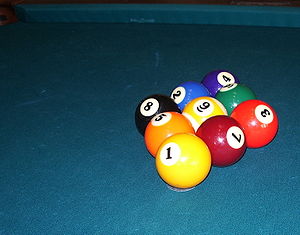
United States
The United States of America is a federal constitutional republic comprising fifty states and a federal district...
and traceable to the 1920s. The game may be played in social and recreational settings by any number of players (generally one-on-one) and subject to whatever rules are agreed upon beforehand, or in league and tournament
Tournament
A tournament is a competition involving a relatively large number of competitors, all participating in a sport or game. More specifically, the term may be used in either of two overlapping senses:...
settings in which the number of players and the rules are set by the sponsors. During much of its history, nine-ball has been known as a "money game
Gambling
Gambling is the wagering of money or something of material value on an event with an uncertain outcome with the primary intent of winning additional money and/or material goods...
" in both professional and recreational settings, but has since become established as a legitimate alternative to eight ball
Eight ball
Eight-ball is a pool game popular in much of the world, and the subject of international professional and amateur competition...
, straight pool
Straight Pool
Straight pool, also called 14.1 continuous or simply 14.1, is a pocket billiards game, and was the common sport of championship competition until overtaken by faster-playing games like nine-ball...
and other major competition games.
In recent decades, nine-ball has become the dominant tournament game in professional pool, in the World Pool-Billiard Association
World Pool-Billiard Association
The World Pool-Billiard Association is the international governing body for pocket billiards . The group was formed in 1987, and was initially headed by a provisional board of directors consisting of representatives from Japan, the United States, Sweden, and Germany...
, Women's Professional Billiard Association
Women's Professional Billiard Association
The WPBA is a professional women's billiards tour based in the United States. It was originally founded in 1976 as the Women's Professional Billiard Alliance by players Madelyn Whitlow and Palmer Byrd, as well as Larry Miller ....
and United States Professional Poolplayers Association. Matches proceed quickly, suitable for the time constraints of television
Television
Television is a telecommunication medium for transmitting and receiving moving images that can be monochrome or colored, with accompanying sound...
coverage, and the fast-paced games tend to keep the audience engaged. The sports network ESPN
ESPN
Entertainment and Sports Programming Network, commonly known as ESPN, is an American global cable television network focusing on sports-related programming including live and pre-taped event telecasts, sports talk shows, and other original programming....
has been, for several years, a major catalyst for the popularity of nine-ball and a major sponsor of championship play.
Play
The game is played on a pocket billiards table with six pockets and with ten balls. The , which is usually a solid shade of white (but may be spotted in some tournaments), is struck to hit one or more of the other nine balls (often referred to as ), each of which is distinctly colored and numbered 1 through 9. The object of the game is to legally pocket the 9-ball.In nine-ball, except when a push-out has been invoked, a legal shot consists of striking the cue ball into the lowest numbered object ball on the table and subsequently either pocketing an object ball, or driving any ball (including the cue ball) to any rail, otherwise the shot is a . Additional conditions apply for the break shot (see below.) Object balls do not have to be pocketed in numerical order; Any ball may be pocketed at any time during the game, so long as the lowest-numbered ball is contacted first by the cue ball. Nine-ball is not a game. The 9-ball itself can be legally pocketed for a win at any turn in the game, intentionally or by chance, including the break shot. Conversely, a player could potentially pocket all of the object balls numbered one through eight during the course of the game and lose after his opponent pockets only the nine-ball.
Players alternate at the table, meaning play continues by one player until he or she misses, commits a foul, or pockets the 9 ball for the win. The penalty for a foul is that the player's inning ends and the opponent comes to the table with , able to place the cue ball anywhere on the table prior to shooting.
Nine-ball is a relatively fast-paced game and is rarely played by the rack. Instead, players normally play a match (or ) to a set number of games, often five, seven or nine. The first player to win that set number of games wins the match.
The rack
The object balls are placed in a diamond-shaped configuration, with the 1 ball positioned at the front (toward the position of the breaking player) on the foot spot, and the 9 ball placed in the center. The physical rackRack (billiards)
A rack is the name given to a frame used to organize billiard balls at the beginning of a game. Rack may also be used as a verb to describe the act of setting billiard balls in starting position in billiards games that make use of racks , as well as a noun to describe the balls in that starting...
used to position the balls is typically triangle-shaped, usually wood or plastic, and capable of holding all fifteen object balls, although diamond-shaped racks that hold only nine balls are sometimes used. The placement of the remaining balls is generally considered to be random. However, in some tournaments, the ball being to the lesser player must be one of the two balls placed behind the 1 ball at the apex of the rack. An imaginary line drawn through the one-ball and back apex of the diamond should be parallel to the long rails of the table (perpendicular to the short rails.) The placement of balls is expected to be precise, especially in league and tournament play; If any ball in the rack does not touch each adjacent ball, or if the rack is not "straight", or if the 1 ball is not resting precisely on the , the player assigned the break may demand a re-rack. (See also "European alterations", below, for a recently devised "template-trained" racking system.)
The break
One person is chosen to shoot first, by the rack. Usually this is determined by flipping a coin, or by , especially in professional tournaments in the case of the latter, or it may be ruled by the authority in charge, the sponsor or the players themselves that the winner or loser of the previous game will always shoot first in the next rack. As with most pocket billiard games, the base of the cue ball must be behind the for the break shot. If the player who breaks fails to make a legal break, the opponent can either demand a re-rack and become the breaker, or continue to play as if it had been an ordinary foul, depending upon the rules of the event. If the breaker pockets a ball and commits no foul, it remains the breaker's turn. If the breaker pockets the 9 ball on the break (without fouling), this is an instant win. (See also "European alterations", below, for recent moves to change the breaking rules.)The push-out
After the break (regardless of its result), before the second shot of the game, the player at the table may call a "." A push-out can be called by the breaking player if he legally pocketed a ball on the break, or the non-breaking player if no ball was pocketed on the break. Calling a push-out for the shot after the break allows the player taking the shot to legally hit the cue ball in almost any fashion with no foul, with the exception that the cue ball must stay on the table and illegal shots such as double-hitting the cue ball or a "scoop jump shot" should still be called a foul. The main purpose of the push-out shot is to alleviate an unlucky lie after the break, where it is difficult to make a legal shot. Unlike any other shot of the game, for a push-out shot, the cue ball is not required to contact any object ball and if an object ball is contacted, it is not required to be the lowest numbered ball. If the nine-ball is pocketed on a push-out shot it is spotted, however any other pocketed object ball stays down. A push-out should be called so that the opponent or referee hears the call, and it is customary for the opponent or referee to confirm that he heard the push-out call, so that there is no controversy surrounding the shot. After a push-out shot was called and played, the incoming player has the choice of accepting the table as it lies, or forcing the pushing-out player to take the next shot of the game (always the third shot of the game.) Only one push-out is allowed per game, and it must be immediately after the break. (See also "The rise of 'Texas express' rules", below, for the historical multi-push-out rule variation.) If the pushing-out player has a particular type of shot he feels comfortable with, such as a jump shot, or two-rail bank shot, it may be strategical to leave that type of shot after the push-out. The ideal push-out shot leaves a lie that the opponent believes likely to be makeable, and will accept, but will fail to actually make, giving control of the table back to the pusher-out, and which the pusher-out is confident to make if the shot is passed back to him. Thus nine-ball players aim for a push-out that has about a 50/50 chance of being accepted or returned.Winning
Winning a game occurs any time a player hits the lowest numbered ball first and pockets the 9-ball without committing a foul. When only the 9-ball is on the table, this is straightforward and obvious; however, when other balls remain on the table, any number of events can result in victory so long as the above requirements are met. Loss of game can occur if three successive fouls are committed and the fouling player is warned audibly or visually after the 2nd foul during the third inning.In most rule systems, including those of the World Pool-Billiard Association
World Pool-Billiard Association
The World Pool-Billiard Association is the international governing body for pocket billiards . The group was formed in 1987, and was initially headed by a provisional board of directors consisting of representatives from Japan, the United States, Sweden, and Germany...
and its national affiliates like the Billiard Congress of America
Billiard Congress of America
Billiard Congress of America is a governing body for cue sports in North America , the regional member organization of the World Pool-Billiard Association...
, if a player fouls and pockets the 9 ball, or knocks the 9 ball off the table, the 9 ball is placed on the foot spot, and the incoming player receives .
Rule variations and governing bodies
The general rules the game is played under are fairly consistent and usually do not stray too far from the format set forth in the Billiard Congress of AmericaBilliard Congress of America
Billiard Congress of America is a governing body for cue sports in North America , the regional member organization of the World Pool-Billiard Association...
(BCA) BCA World Standardized Rules for Nine Ball, which have merged with those of the World Pool-Billiard Association
World Pool-Billiard Association
The World Pool-Billiard Association is the international governing body for pocket billiards . The group was formed in 1987, and was initially headed by a provisional board of directors consisting of representatives from Japan, the United States, Sweden, and Germany...
(WPA), to form the World Standardised Rules, although amateur league play may be governed by similar but slightly different rules promulgated by the American Poolplayers Association
American Poolplayers Association
The American Association was founded in 1981 by professional pool players Terry Bell and Larry Hubbart, although with roots dating back to the National Pool League , founded in 1979. The APA conducts a system of franchised-based local amateur leagues of pool competition, including both...
(APA) and other organizations.
The rise of "Texas express" rules
For much of its history nine-ball rules allowed participants to "" multiple times during a game (see "The push-out", above, for the modern push-out rules), meaning any player could call a "push-out", and then hit the cue ball to any area on the table without being penalized by normal rules, such as failure to contact the lowest-numbered ball on the table. However, once a push-out was called and executed, the incoming player had the right to shoot or give the inning back to the opponent. If the player shooting the resulting shot fouled, the other player would have ball-in-hand; hence this manner of play was called the "two-foul" version. "One-foul" became popular in the 1970s, as play turned more aggressive for the early televised matches. This newer version of nine-ball awarded ball-in-hand on any cue ball foul. A now-standard rule variant, which started to sweep the sport of nine-ball in the mid-1980s, restricted the push-out option to once per game and only to the inning immediately following the break. This change profoundly affected the way the game was played. By about 1990 this new push-out rule had become ubiquitous and it and any additional rules appended to it were collectively referred to as "" rules, so called because of the supposed US state of origin and the speeding up of the game. Today, Texas express push-out rules dominate the way nine-ball is played and is the variant incorporated into the official rules maintained by the WPA and its affiliates like the BCA.European alterations
As of the 2000s, the rules have been somewhat in flux in certain contexts, especially in Europe. The European Pocket Billiard FederationEuropean Pocket Billiard Federation
The European Pocket Billard Federation is the European governing body for pocket billiards. EPBF is the European regional affiliate member of the World Pool-Billiard Association .-EPBF members:National affiliate members of EPBF :...
(EPBF), BCA's WPA-affiliate counterpart in Europe, has done away with standardized racking techniques, and instead relies upon in the cloth to position the balls, with no physical ball rack
Rack (billiards)
A rack is the name given to a frame used to organize billiard balls at the beginning of a game. Rack may also be used as a verb to describe the act of setting billiard balls in starting position in billiards games that make use of racks , as well as a noun to describe the balls in that starting...
required; these indentations are carefully created using a "", such that the divots are slightly closer together than they would be expected to be, thus creating ball-on-ball pressure as the balls settle partially into the divot pattern, into which they cannot quite fit. This results in an especially tight rack, without any possibility of cheating by carefully manipulating the ball positions while racking. This innovative racking technique was invented and patented http://patimg1.uspto.gov/.piw?Docid=D0433724&homeurl=http%3A%2F%2Fpatft.uspto.gov%2Fnetacgi%2Fnph-Parser%3FSect2%3DPTO1%2526Sect2%3DHITOFF%2526p%3D1%2526u%3D%25252Fnetahtml%25252FPTO%25252Fsearch-bool.html%2526r%3D1%2526f%3DG%2526l%3D50%2526d%3DPALL%2526S1%3DD433724.PN.%2526OS%3DPN%2FD433724%2526RS%3DPN%2FD433724&PageNum=&Rtype=&SectionNum=&idkey=NONE&Input=View+first+page as the Rack-M-Rite Racking Template by US professional player David Smith and his partner Dale Craig and first used in professional events on the Billiard Channel Tour in 2000 by tournament director David Vandenburgh. It is now the official rack of the EPBF Euro-Tour.
Another Euro-Tour innovation is a new requirement that the break shot be taken from a "", not unlike break shot zone used in snooker
Snooker
Snooker is a cue sport that is played on a green baize-covered table with pockets in each of the four corners and in the middle of each of the long side cushions. A regular table is . It is played using a cue and snooker balls: one white , 15 worth one point each, and six balls of different :...
and blackball
Blackball
Blackball, black-ball or black ball may refer to:-Society and culture:* Blackballing, ostracizing someone socially, e.g. prevention of finding local or field-specific employment, blacklisting from a club or other organization, etc-Geography:...
, consisting of the middle 50% of the . This change defeats the common break-from-the-side-rail technique for pocketing the 9 ball on the break and winning the game instantly. While 9 ball breaks are still possible, they are much more difficult under the new rule. This requirement was recently added to the Europe vs. US all-star
All-star
All-star is a term designating an individual as having a high level of performance in their field. Originating in sports, it has since drifted into vernacular and been borrowed heavily by the entertainment industry...
team event, the Mosconi Cup
Mosconi Cup
The Mosconi Cup is an annual nine-ball pool tournament contested between teams representing Europe and the USA since 1994. The trophy is named after American player Willie Mosconi, and is modeled on and compared to the Ryder Cup in golf...
, but has not otherwise been seen much by North Americans.
Yet a third EPBF change, used on the Euro-Tour for several years, is the "" rule, a stringent requirement that in order for a break shot to be legal, at least three object balls must either be pocketed or come up-table and cross the . Failure to do so constitutes a loss-of-turn (but not ) foul – even if two object balls are pocketed, a potential major windfall for the non-breaking player under these rules. More stringently yet, the requirements are independent – if a ball crosses the head string and is then pocketed, it counts as a pocketed ball but not a head string-crossing ball. This alteration (from WPA's requirement that one object ball be pocketed or four driven to cushions) requires a powerful break shot, and was instituted to thwart a different form of break manipulation, the recently developed "nine-ball soft break", in which a languid break performed correctly, and given a tight rack (such as that produced by EPBF template-trained racking), is almost guaranteed to pocket a in a , perhaps even both wing balls, meanwhile the remaining balls stay mostly or entirely on the foot end of the table, giving the breaker an easy of short shots. By effectively banning the soft break, wins "on a silver platter" are much less likely. One problem with this "three above the line" break requirement is that very careful attention must be paid to whether or not particular balls cross the head string, such that even professional referees have had to resort to video playback, as happened several times at the Mosconi Cup, when this rule, too, was introduced in 2007 by the MC's organizers, Matchroom Sport
Matchroom Sport
Matchroom Sport is a sport event promotions company founded by the English entrepreneur Barry Hearn. It first came to attention in the sports of snooker and boxing and is also involved in pool, bowling, golf , fishing, darts and poker...
, in an effort to make the event more competitive and interesting to audiences, and more even (the US has mostly dominated the annual event since its inception, and they did in fact lose the 2007 match).
Another Mosconi Cup rule change in 2007 called for racking such that the 9 ball rather than the 1 ball is on the (i.e. the racker rolls the balls forward farther; the balls remain in the same position in the rack), which further thwarts pocketing a wing ball easily.
Three-ball (historical)
While the modern folk game of three-ball bears no resemblance to nine-ball, the earliest-known version of three-ball was essentially nine-ball played with only three balls, racked in a triangle, in which the 3 ball was the . It is a quick game, and (due to the comparatively very high possibility of pocketing the 3 ball on the break) one with a more significant luckLuck
Luck or fortuity is good fortune which occurs beyond one's control, without regard to one's will, intention, or desired result. There are at least two senses people usually mean when they use the term, the prescriptive sense and the descriptive sense...
component than nine-ball and most other pool games.
Six-ball
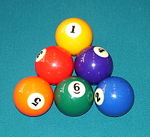
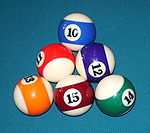
Pool hall
A billiard/billiards, pool or snooker hall is a place where people get together for playing cue sports such as pool, snooker or carom billiards...
that charged by the rack instead of by the hour, as nine-ball players had already paid for the 10–15 balls and did not want to waste them. This explanation of the game's origin may be particularly plausible because six-ball remains popular today as a diversion or practice round among nine-ball-playing players, using coin-operated tables that deliver a full set of fifteen balls.
Seven-ball
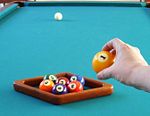

ESPN
Entertainment and Sports Programming Network, commonly known as ESPN, is an American global cable television network focusing on sports-related programming including live and pre-taped event telecasts, sports talk shows, and other original programming....
's Sudden Death Seven-ball
Sudden Death Seven-ball
Sudden Death Seven-ball was an annual pool tournament held in the United States; it was broadcast on and sponsored by ESPN. SDSB was the most notable event featuring the game of seven-ball...
which aired in the early 2000s. Though hardly necessary, specialized equipment for the game can be purchased, including a unique black-striped seven ball and a hexagonal rack.
Ten-ball
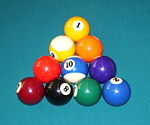
Carom nine-ball
Carom nine-ball (also carom nine, for short) is played with the usual nine-ball rack, but breaking with the 1 ball, with the cue ball placed at the head of the rack (in the usual place of the 1 ball). As in regular nine-ball, play progresses from the lowest-numbered ball on the table; however a legal shot is made by shooting the object ball rather than the cue ball. The object ball must make first contact with the cue ball to count as a legal shot, the goal being to carom the object ball into a pocket or into another ball. Once a legal shot has been performed, any ball then sunk counts for that player; the winner is the player to first pocket the nine-ball after a legal shot.External links
- WPA/BCA World Standardized Rules for nine-ball
- Pro9 — website detailing the many nine-ball tournaments held within the British Isles and beyond.
- Historical nine-ball and ten-ball match videos by year

